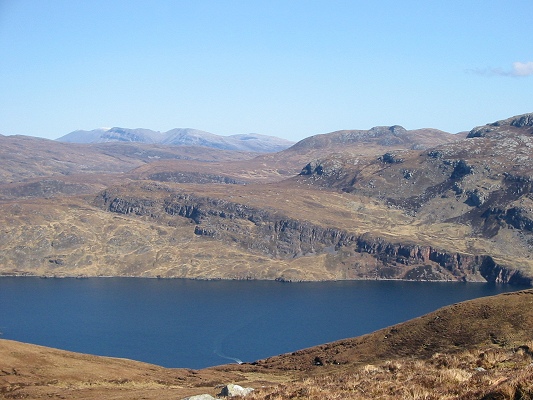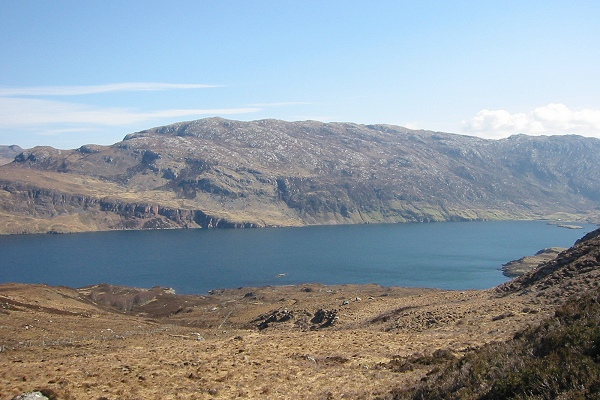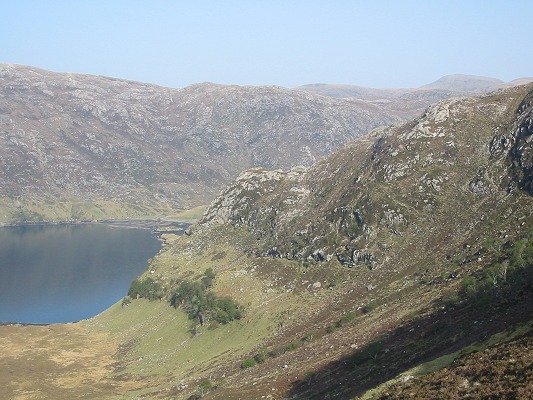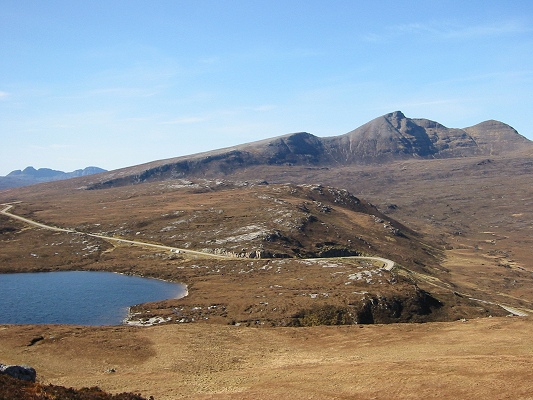
| Home | Geological History | Stratigraphy | Area map | Rock Index | About |
| Scourie | Achmelvich | Laxford | Clachtoll | Stoer | Assynt | Skiag Bridge | Glencoul | Knockan | Borralan | Ledmore |
Loch Glencoul is, like Knockan Crag, an excellent place to view the effects of thrust faulting during the Caledonian mountain building. Older metamorphic rocks have been moved on top of the Cambrian succession on a major thrust fault, the Glencoul Thrust. Here, however, the Moine Thrust zone is more complicated than at Knockan, and contains a number of stacked-up slices. The metamorphic rock above the Glencoul Thrust is Lewisian Gneiss, like that found underneath the Torridonian and Cambrian. The Moine Thrust itself, with its overlying Moine Schists, lies at a higher level, appearing at the surface further to the east of Loch Glencoul.

![]() View to the north across Loch Glencoul. The prominent
straight line of crags in the centre is made of the
Cambrian basal quartzite and Pipe Rock. On the northern
side of Loch Glencoul all the Torridonian rocks were eroded
away before the Cambrian was deposited, so the quartzites
rest directly on Lewisian Gneiss, which makes up the
hummocky rocky ground beneath and to the left of the crags.
Above the quartzite crags is a gentle slope underlain by
the softer Fucoid Beds. Also in this slope are two
closely-spaced overthrust faults, the Sole Thrust and the
Glencoul Thrust. The Glencoul Thrust places more Lewisian
Gneiss on top of the Cambrian rocks, and the gneiss can be
seen in rugged outcrops where the slope becomes steep
again.
View to the north across Loch Glencoul. The prominent
straight line of crags in the centre is made of the
Cambrian basal quartzite and Pipe Rock. On the northern
side of Loch Glencoul all the Torridonian rocks were eroded
away before the Cambrian was deposited, so the quartzites
rest directly on Lewisian Gneiss, which makes up the
hummocky rocky ground beneath and to the left of the crags.
Above the quartzite crags is a gentle slope underlain by
the softer Fucoid Beds. Also in this slope are two
closely-spaced overthrust faults, the Sole Thrust and the
Glencoul Thrust. The Glencoul Thrust places more Lewisian
Gneiss on top of the Cambrian rocks, and the gneiss can be
seen in rugged outcrops where the slope becomes steep
again.

![]() This view towards the north shore of Loch Glencoul shows
the Cambrian quartzite crags on the left, the Glencoul
Thrust above them, and then, occupying the rest of the
ridge to the right, Lewisian gneiss that makes up the thick
slab of older metamorphic rock above the Glencoul Thrust.
This view towards the north shore of Loch Glencoul shows
the Cambrian quartzite crags on the left, the Glencoul
Thrust above them, and then, occupying the rest of the
ridge to the right, Lewisian gneiss that makes up the thick
slab of older metamorphic rock above the Glencoul Thrust.

![]() This photograph of the south shore of Loch Glencoul looks
directly along the outcrop of the Glencoul thrust plane.
In the centre of the picture a clear straight line separates
the rugged Lewisian gneiss outcrops above the thrust from
the green slopes beneath. The row of dark green bushes is
growing on outcrop of the Fucoid Beds. On the right-hand
skyline in the far distance lie Moine schists, above the
top of the Moine thrust zone in the east.
This photograph of the south shore of Loch Glencoul looks
directly along the outcrop of the Glencoul thrust plane.
In the centre of the picture a clear straight line separates
the rugged Lewisian gneiss outcrops above the thrust from
the green slopes beneath. The row of dark green bushes is
growing on outcrop of the Fucoid Beds. On the right-hand
skyline in the far distance lie Moine schists, above the
top of the Moine thrust zone in the east.

![]() This view looks in the opposite direction away from Loch
Glencoul. The smooth slope of the skyline ridge and the
middle ground beyond the Loch, dipping away to the left, is
parallel to bedding planes in the Cambrian Pipe Rock. In
the distance, below the peak, you can see darker,
flat-lying strata belonging to the Torridonian sandstone.
This view looks in the opposite direction away from Loch
Glencoul. The smooth slope of the skyline ridge and the
middle ground beyond the Loch, dipping away to the left, is
parallel to bedding planes in the Cambrian Pipe Rock. In
the distance, below the peak, you can see darker,
flat-lying strata belonging to the Torridonian sandstone.
are mostly the same as those seen at Skiag Bridge, with the exception of sheared varieties of the Lewisian Gneiss from the Glencoul Thrust.
|
Quartz sandstone (orthoquartzite), Cambrian Loch Assynt |
|
Quartz sandstone with vertical burrows, Cambrian Pipe Rock Loch Assynt |
|
Calcareous siltstone, Cambrian Fucoid Beds Loch Assynt |
|
Mylonite formed from Lewisian Gneiss, Moine Thrust Zone Loch Eriboll |
|
| Scourie | Achmelvich | Laxford | Clachtoll | Stoer | Assynt | Skiag Bridge | Glencoul | Knockan | Borralan | Ledmore |
| Home | Geological History | Stratigraphy | Area map | Rock Index | About |
D.J. Waters, Department of Earth Sciences, May 2003